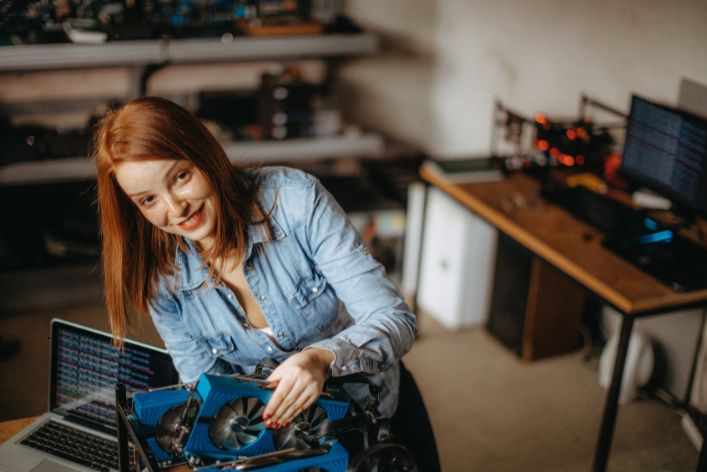Crypto mining has created quite a splash among miners, investors, and hackers alike.
This is despite the fact that it has only been around since Bitcoin was initially mined in 2009.
In internet forums, crypto mining is a hot topic.
You’ve probably seen movies and articles on cryptocurrencies like Bitcoin, Dash, Ethereum, etc.
And the topic of Bitcoin mining frequently comes up in those pieces of information.
But you might be thinking, “What is Bitcoin mining?” or “What is crypto mining?”
Mining is the process of collecting cryptocurrency as a kind of payment for work completed.
But why do individuals mine cryptocurrency?
Some people are seeking a second source of income.
Others want more financial freedom without the interference of governments or banks.
Cryptocurrencies are a burgeoning topic of interest for technophiles, investors, and cyber criminals for whatever reason.
So, in a more technical sense, what is cryptocurrency mining, and how does it work?
Let’s have a look at it in more detail.
What is Mining?
In the context of blockchain technology, mining is the process of adding transactions to the blockchain.
This blockchain is a vast distributed public database of existing transactions.
Innovative Tech Solutions, Tailored for You
Our leading tech firm crafts custom software, web & mobile apps, designed with your unique needs in mind. Elevate your business with cutting-edge solutions no one else can offer.
Start NowAlthough mining is most commonly associated with Bitcoin, it is also used in other blockchain-based technologies.
Bitcoin mining pays out more bitcoins to those who run mining companies.
Bitcoin mining involves creating new bitcoins by solving problems.
It is made up of competing computing systems with specialised chips that compete to solve mathematical puzzles.
The first bitcoin miner to solve the riddle receives bitcoin as a prize.
In addition, the mining process verifies and trusts transactions on the Bitcoin network.
Bitcoin was initially mined on desktop computers with conventional CPUs.
However, the procedure was painfully slow.
Now, massive mining pools spread across many countries create Bitcoin.
Bitcoin miners group together mining devices that use a lot of power to mine the cryptocurrency.
Bitcoin mining harms the environment where electricity comes from fossil fuels.
As a result, several Bitcoin miners have relocated their operations to locations with renewable energy sources, reducing Bitcoin’s carbon footprint.
Read: All You Need To Know About Cryptocurrency

How Does Mining Work?
You might have pondered trying your hand at bitcoin mining.
Anyone with a decent home computer could participate a decade ago.
However, as the blockchain has grown in popularity, so has the processing power necessary to keep it running.
In October 2019, mining one Bitcoin needed 12 trillion times the computational power of January 2009.
As a result, hobbyist bitcoin mining is unlikely to be viable in the near future.
Almost all mining is now done by specialized corporations or groups pooling their resources.
It’s still useful to understand how it works, though.
Specialized computers carry out the calculations required to validate and record each new bitcoin transaction, as well as to ensure the blockchain’s security.
Verifying the blockchain necessitates a significant amount of processing power, which is provided voluntarily by miners.
Bitcoin mining is similar to managing a large data centre.
Companies buy mining equipment and pay for the electricity that keeps it functioning (and cool).
Seamless API Connectivity for Next-Level Integration
Unlock limitless possibilities by connecting your systems with a custom API built to perform flawlessly. Stand apart with our solutions that others simply can’t offer.
Get StartedThe value of the mined coins must be greater than the cost of mining those coins in order for this to be profitable.
What drives miners to work?
The network holds a lottery.
Every machine on the network competes to be the first to guess a “hash,” a 64-digit hexadecimal number.
The miner is more likely to get the incentive if the computer can spew out guesses quickly.
The winner receives a predetermined quantity of newly minted bitcoin and updates the blockchain ledger with all newly validated transactions.
This effectively adds a newly verified “block” comprising all of those transactions to the chain.
This happens every ten minutes on average.
The payout was 6.25 bitcoin as of late 2020.
However, it will be cut in half in 2024 and every four years after that.
In fact, as mining difficulty rises, the payout will fall until there are no more bitcoins to mine.
Only 21 million bitcoins will ever exist.
In theory, the final block should be mined in 2140.
Miners will no longer rely on newly produced bitcoin as a reward.
Instead, they will rely on the fees they charge for transactions from that point forward.
Read: How to Value Cryptocurrencies for Investment
Why is Crypto Mining Important?
Mining is crucial to the security of Bitcoin (and many other cryptocurrencies) in addition to releasing new coins into circulation.
If no one authorised transactions, the decentralised structure of the blockchain might allow fraudsters to spend cryptocurrency multiple times at the same time.
Mining secures and verifies the blockchain, allowing cryptocurrencies to operate as a peer-to-peer decentralised network without the need for third-party control.
It also encourages miners to give their computer power to the network, as well as increases user trust in the coin.
Read: Cryptocurrency Investing 101: A Beginner’s Guide

How To Start Mining Cryptocurrency
Individuals who want to mine Bitcoin can either own and operate a mining gear or buy hash rate from a third-party rig, often known as cloud mining.
The initial cost of specialised hardware, as well as continuing operational costs such as energy, are all part of owning and maintaining a mining rig.
Miners, on the other hand, have the most control and profit possibilities.
Transform Business with Custom CRM & ERP Solutions
Elevate your operations with a CRM or ERP tailored for you. Let’s build the perfect solution that others can't replicate—crafted to match your business's needs like no other.
Get StartedCloud mining, on the other hand, does not require an initial investment and allows miners to contribute only what they can afford.
New miners, in either event, will require cryptocurrency mining software to participate.
Crypto mining applications are commercial or open-source software solutions that make it easier.
Crypto mining apps provide platforms for mining pools, bringing together interested miners with and without rigs to pool their computing resources and mine cryptocurrency.
Average miners with minimal resources need software to participate alongside a mining farm.
Conclusion
Curiosity and a strong will to learn are a prerequisite for aspiring crypto miners.
As new technologies develop, the crypto-mining space is continuously changing.
Professional miners continually analyze the space and optimize their tactics to increase performance.
Climate change activists grow increasingly concerned as more fossil fuels burn to power the mining process.
As a result of these concerns, cryptocurrency communities like Ethereum are considering transitioning from proof-of-work frameworks to more sustainable frameworks like proof-of-stake frameworks.
Before you go…
Hey, thank you for reading this blog to the end. I hope it was helpful. Let me tell you a little bit about Nicholas Idoko Technologies.
We help businesses and companies build an online presence by developing web, mobile, desktop, and blockchain applications.
We also help aspiring software developers and programmers learn the skills they need to have a successful career.
Take your first step to becoming a programming boss by joining our Learn To Code academy today!
Be sure to contact us if you need more information or have any questions! We are readily available.











